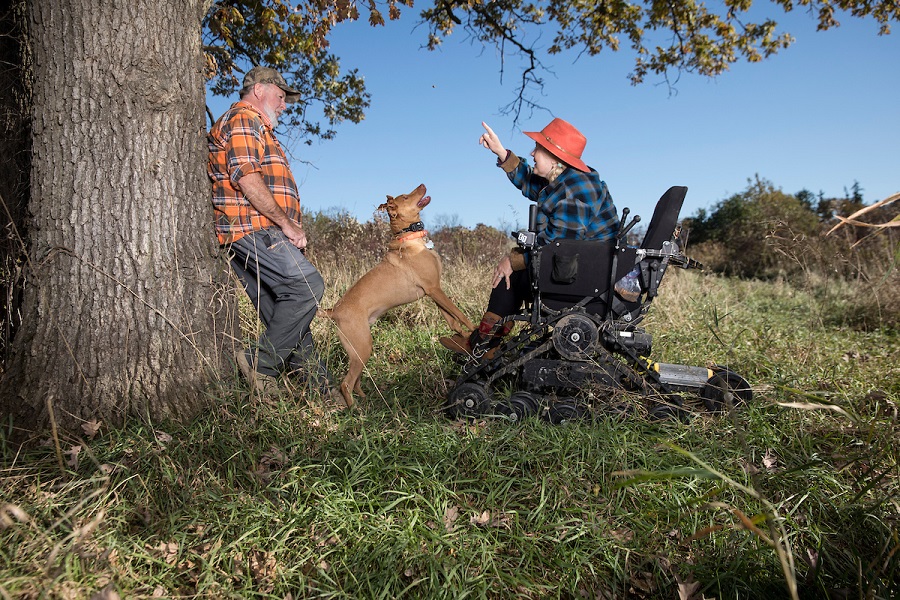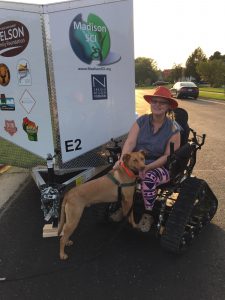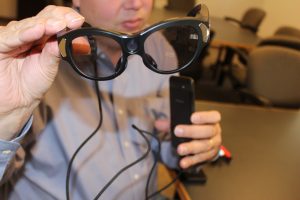Moving Toward Mobility

moving toward mobility
Photo courtesy of Jenn Ackerman and Tim Gruber
How adaptive technology is changing lives in Wisconsin
Monica Spaeni did it all — hiking, archery, martial arts — before a spinal cord injury left her unable to fully enjoy the outdoors 19 years ago.
Spaeni wasn’t ready to give up an active life, though. Instead, she created the Madison Spinal Cord Injury Group, which creates recreation opportunities among people with mobility challenges.
After attending a UW-Madison adaptive fitness class and floating in a kayak for “less than five seconds,” before flipping, Spaeni knew she needed to do more with adaptive technology. So, as a part of the group, she wrote a grant for its first adaptive kayak and helped the group acquire handcycles, which are bicycles pedaled with the hands instead of the feet.
This was a great start, but it wasn’t until another member offered Spaeni the opportunity to take an outdoor wheelchair (known as a “trackchair,” because it uses tracks rather than wheels) for a spin that Spaeni realized what else could become accessible for her and the community of people with spinal cord injuries.
“It was the first time I could walk in the woods again like I used to hike. I could walk with my husband, and we could go through the marsh, I could go through the corn fields,” Spaeni says. “I knocked down as many stalks as I could. It felt so free.”
According to the Wisconsin Department of Health Services, more than 600,000 Wisconsinites self-identify as having a disability. Of these, more than half have difficulty walking, and about 90,000 have difficulty seeing. Navigating spaces can be uniquely challenging for people with these and other disabilities, but advances in adaptive technology — some of it developed here in Wisconsin — are helping to create new opportunities for people with mobility and vision challenges.
Accessing the outdoors
Track chairs not only allow individuals like Spaeni to relish the outdoors further, they also allow them to feel more independent.
“I was a mom with a third-grader and a fifth-grader when I had my injury. And there were so many events that I could go to, but my kids didn’t want to go and watch their mom,” says Spaeni. “They want to go to an event and [participate] with their parents.”
Now, parents like Spaeni have this opportunity.

Spaeni and her dog can head to whatever outdoor adventure they have planned next with the help of these rentable event trailers, transporting track chairs with ease. (Photo courtesy of Steve Spaeni)
Still, trackchairs can be cost prohibitive for some users — each one costs more than $13,000. So, Spaeni established Access Ability Wisconsin to loan 15 of these chairs to individuals, groups and events for a $50 deposit. With eight pick-up locations across Wisconsin and trailers available for transport, Spaeni and Access Ability Wisconsin have transformed what outdoor recreation looks like for people who use wheelchairs.
Trackchairs can also play an important role in improving accessibility for those who work outdoors.
Jeff Olson is an arborist in Oregon, Wisconsin, just south of Madison. He owns and manages Arbor Systems and was already in the tree-care business in 1997 when he was injured in a fall from a deer hunting stand that left him a paraplegic. After his injury, Olson wondered whether he would be able to continue in the same line of work.
“At first … I thought I couldn’t do any of it, because I couldn’t climb [trees] myself. But then, as time went on, I realized what I could and couldn’t do. And then I just hired the right people,” Olson says.
Olson became a member of the Wisconsin Arborist Association and spent time establishing contacts and meeting other contractors. For the first year or two after his injury, he only sold work and contracted it out. Eventually, though, he began to invest in equipment and hire a staff. His business has grown to include four employees and state-of-the-art tree care technology. Olson now primarily handles sales and paperwork but says he still does on-site visits for about 80 percent of jobs that the company takes on.
For Olson, adaptive tech makes site visits easier. He has a van that can be driven hands-only, and an all-terrain trackchair, which is versatile enough that it can be used for specialty tasks, like plowing snow.
“It’s really changed my way of getting around, especially the outdoors,” Olson says. “When I’ve got to consult on a land clearing project or something like that, I’ll have to go out. We did a job for Habitat for Humanity, and we had to walk this whole section and pick and choose trees to remove before the houses were built, and it came in handy then.”
Like Spaeni, Olson also uses the chair for recreation. He drives around his five-acre property outside of Oregon with his dogs, Tex and Colby. And he still hunts deer, with a gun rack mounted on the track chair.
“It really goes anywhere you want it to go,” Olson says. “Off road, if there’s not a big stump in the way or a big downfall, it’ll go through woods.”
Reinventing the Wheel
Rowheels, based in the Madison suburb of Middleton, Wisconsin, is taking wheelchair mobility even further with a patented wheel design aimed at decreasing rotator cuff tears and other injuries for wheelchair users.
“Shoulder injury is definitely a risk factor for people long-term with manual wheelchairs,” says Lori Smith, a social worker in Verona, Wisconsin, a suburb of Madison. Smith decided to look into more ergonomic wheelchair designs and assistive technologies after her 11-year-old son, Hayden, who uses a wheelchair, experienced shoulder pain following a YMCA camp at which he spent a lot of time rolling outside on grass.
Rowheels allow users to propel their chairs forward using a rowing motion, rather than pushing as one typically does with a manual wheelchair. The design helps users build core strength and improve posture while decreasing the risk of aches, pains and injuries to the shoulders.
The company was formed in 2011 after a meeting between Salim Nasser, a NASA engineer with a plan to increase wheelchair mobility and comfort, and Rimas Buinevicius, a financier and entrepreneur whose leg fracture made him a wheelchair user for the first time. Since then, Rowheels has progressed from designing wheels to selling its own wheelchair model, the Revolution 1.0.
Particularly therapeutic, the Revolution 1.0 chairs also have assisted brake systems, as the wheel and hand rim are not connected. The hand rims are oval-shaped, with available grip supports for people with reduced hand or wrist movement capabilities.
“There are several medical benefits of Rowheels technology, which has allowed people to be more independent. You have to put your shoulders back, which means you have better breathing. Your diaphragm, your lungs are open, and that leads to long-term mobility,” says Rowheels’ chief executive officer Guarav Mishra.
A new geared wheelchair is also opening doors for patients with spinal cord injuries.
Brooke Slavens, an associate professor at UW-Milwaukee’s College of Health Sciences, is working with researchers from the University of Illinois at Urbana-Champaign and IntelliWheels to develop the new Easy Push geared wheel for wheelchairs.
Patients from the Milwaukee VA Medical Center are testing the new technology. Being able to connect patients with spinal cord injuries to the geared wheelchair is the best reward for the project, Slavens says.
“They’re able to be the first ones, you know, at the forefront of this new technology, trying out the device, seeing how it works and all of the feedback has been very positive,” Slavens says.
The geared wheelchair can help patients who are not as strong or who find it difficult to manually push their wheelchair for long periods of time.
“This does have a lot of potential impact for changing just their everyday lifestyle, you know, while also helping to improve activity levels,” Slavens says. “Someone who otherwise would be sedentary, or in a power wheelchair, could use this type of assistive technology to increase their activity and fitness levels.”
In addition to the physical effects, this could also help with psychosocial issues such as depression and anxiety, which are common in those with spinal cord injuries, Slavens says, adding that this new assistive technology could change lives, allowing for people to engage in meaningful activities such as going to work or visiting friends.
“The difference of being able to go out to the community and seeing your friends, seeing your family, even participating in adaptive sports or therapeutic types of recreation has been shown to really make for a more meaningful and engaged lifestyle,” Slavens says.
While some forms of assistive technology, like eyeglasses, are common and widely accepted, a better understanding of what assistive technology is could help remove the stigma surrounding it, according to Slavens.
“I think coming together as a community would be so helpful just to better understand and advocate for new assistive technology,” Slavens says. “Some of the engineering along with art and design could make things more exciting to use, and more appealing.”
Navigating without sight
Another Middleton company is aiming to improve mobility for people with disabilities. Wicab, Inc is a tech startup that is developing a navigation-aid technology for a different group of users: individuals who are profoundly blind.
One of Wicab’s products is the BrainPort Vision Pro, which uses electrotactile stimulation of the tongue to help patients perceive the environment around them.

A demonstration of the BrainPort Vision Pro, which helps profoundly blind patients navigate using a camera and electrotactile stimulation of the tongue. (Photo courtesy of Bill Conn at Wicab, Inc.)
“A digital camera creates a view of the environment … and then takes that image and turns it into a grayscale, [pixelated] version of the image,” says Patricia Grant, Wicab’s director of clinical research. “Then it transmits that into what is known as electrotactile stimulation patterns … on the tongue. They’re very, very gentle. It feels like carbonation of a beverage, but it’s a very distinct pattern.”
After getting enough practice, Grant says, users are able to learn how to interpret those signals as images. They’re not seeing, but they are perceiving what’s around them. Grant says users have found the BrainPort Vision Pro helps with a wide variety of activities.
“[One user] is an artist, and she’s able to use it to identify different shapes,” Grant says.
The device can also make it easier for users to determine where they are in relation to doorways or people nearby. According to Grant, clinical studies have shown that it works equally well both for users who had sight and then lost it — and thus have memories associated with certain shapes — and for users who have never experienced sight. Regardless of past experiences, the BrainPort Vision Pro allows users to assign new memories to the patterns they feel on their tongues that correspond to physical objects in the environment.
The BrainPort’s resolution is not sufficient for users to differentiate between the facial features of different people, Grant says, but longtime users do report being able to see when facial expressions change in some cases. Sometimes it’s also possible for users to differentiate between people they know.
“We had someone who had children, who was able to tell which of the kids was in the room [by using the BrainPort],” Grant says.
Part of what makes the BrainPort device especially valuable to users is that it is hands-free, which means it can work in tandem with a cane or guide dog.
Adaptive maps
In addition to visual cues, maps are an integral navigation tool. But programs like Google Maps and Waze rely on visual guides in addition to their audio components, making them difficult for people who are blind or visually impaired to use.
Organizations such as Audio & Braille Literacy Enhancement, or ABLE, can serve as an intermediary between navigation materials and those in need of additional assistance. By providing alternative ways for people with print disabilities to read — by using Braille technology, audio supplements and other technologies — groups like Milwaukee-based ABLE are broadening the independence of those with vision challenges.
“Having Braille materials, audio recordings, and tactile depictions of maps and other illustrations allows us to be included in and participate fully in the same activities as our sighted peers,” says Cheryl Orgas, the group’s executive director. “Unlike the myth that Braille is obsolete, technology has made Braille more readily accessible. Numerous audio options give us much more access to books, magazines and any other material available in standard print.”
ABLE produces maps with deep ridges and textured elements to depict structures such as roads or obstacles. Orgas can point to specific examples of infrastructure in Milwaukee where tactile maps facilitate mobility.
“Being able to understand [things such as] the complex intersection at Ogden and Franklin by studying a tactile map makes travel easier,” she says.
Maps are only a small fraction of the work the group does. It prints all sorts of typically-read materials, such as restaurant menus, medical forms, playbills, Spanish, Latin and German learning resources, and more.
“Having this access also gives us a fuller breadth of knowledge and experience in life’s everyday activities whether it be school, work or recreation,” Orgas says. “The proliferation of technology opens up our world to many more experiences.”
Adaptive apps
Smartphones and other modern conveniences have made information and services easier to access than ever. While some people lament how dependent on cell phones society has become, what is considered a modern convenience to an able person can change the lives of those who are blind or visually impaired.
Imagine walking into an office building, a hospital, a school or another large, confusing building. Everyone knows the feeling of being overwhelmed and needing to find a map or a front desk to seek more information. But what if you could not rely on your sense of sight to find those essential resources?
Now imagine that you can pull out a smartphone, press a button and be instantly connected with a live agent who can act as your eyes and guide you to where you need to be.
That is how Aira helps solve this problem for the blind and visually impaired. Aira is an app that users can download which connects them with a trained professional. Using a pair of goggles with a camera embedded in the center that is connected to a Samsung smartphone, help with navigation is instantly available.
“I can push [a] button twice and I’ll connect to an agent, and the agent can see whatever’s happening,” says Jim Denham, an assistive technology specialist at the Wisconsin Council of the Blind & Visually Impaired. “This is the camera here in the center … They can describe to me what they’re seeing and what [is] around me.”

Aira live agents can be a person’s “eyes” through the camera embedded in this pair of glasses. (Photo by Maddie Boulanger)
Denham says it’s possible to pan a room with the camera and ask what it’s seeing. “And they can say, ‘Oh, I see an elevator straight ahead,’ or ‘I see, you know, a front desk over to the right,’” he says.
“For people who are younger and middle-aged, the iPhone and mobile devices are really doing a lot to enhance the world,” Denham says. “There’s a lot of things that can be done with iPhone that replace some traditional pieces of technology that are out there.”
Apps can read printed material such as menus at a restaurant or identify what currency is in your wallet. Smart home devices can change the temperature in the house or send a notification when the washer or dryer has stopped running. Voice-activated personal assistants like Alexa, Siri or Google Home can help search information, keep a calendar, set a timer, make phone calls, tell time, purchase goods online or play music without requiring any physical action.
“Those devices have been huge,” says vision rehabilitation therapist Brent Perzentka of the Wisconsin Council for the Blind and Visually Impaired. “It’s all just in that device, and [users] don’t need to be able to see it or even really feel it to use it. They can just speak to it.”
While there are safety and privacy concerns with some of these devices, the council can help integrate these tools into a person’s life to help them be as independent, and ensure their privacy, as much as possible.
“Whenever we teach somebody how to use a product like this … we always tell people, here’s how to make sure the camera’s off or the microphone’s off,” Denham says.
The council’s goal is to help its clients be as independent as possible. Denham and Perzentka both visit the homes and offices of individuals who are blind or visually impaired to help.
Ride-sharing apps such as Uber or Lyft can be instrumental in gaining access to safe transportation.
“Things like Uber are a huge help to people who are blind or visually impaired,” Denham says. “It’s not cheap, but you can do it.”
To further guarantee a safe ride, Denham, who is visually impaired himself, listens to Google Maps’ voiceover feature to follow along and make sure the driver is going where they say they are.
In the future, self-driving and self-navigating cars would make transportation even more accessible, though that technology may not be available in the near future, Denham says.
“I think that technology is probably still 10 years out, at least because there’s just so many different barriers to it,” Denham says. “It’s a terrific goal, it’s an awesome dream, but I don’t think it’s going to be anything in the near future.”
Other emerging technologies include indoor GPS systems, which also rely on smartphone technology, to help navigate larger buildings such as hospitals. WayAround is one example of how this indoor GPS system could work.
“WayAround basically uses barcode tags and they can put barcodes on things like on a doorway to tell you, ‘Here’s where you’re at, here’s what the directions [are] to get to the next spot’ or something like that,” Denham says.
As technology continues to develop, accessibility and universal design continue to be important, as is keeping the total audience in mind and integrating these features directly into the operating system, Denham says.
“You wouldn’t design a product could just be used by men — that would just be stupid,” Denham says. “Let’s try to design a product can be used by everybody.”
Editor’s Note: Lori Smith is a family member of one of the authors.

Maddie Boulanger
Senior studying strategic communication with a certificate in digital studies

Sam Jones
Senior studying journalism with certificates in environmental studies and development economics

Max Witynski
Graduate student getting a M.A. in journalism